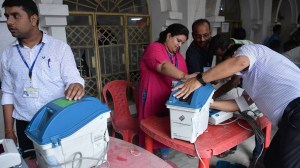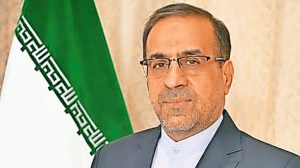- India
- International
The Mahatma’s Footprints: From Mehrauli Dargah to Birla House
January 30 marks the 70th anniversary of the assassination of Mahatma Gandhi. The Indian Express goes back to Birla House in the Capital where he was killed and the Mehrauli dargah he visited three days earlier to retrace his last steps — and to discover what today’s visitors find in their wake.
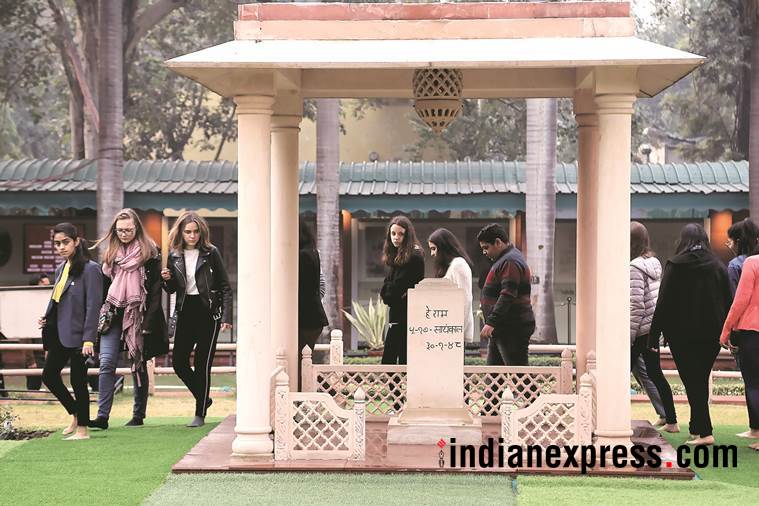 3,000 visitors a day: A group of foreign students at spot where Gandhi was shot. (Express Photo by Abhinav Saha)
3,000 visitors a day: A group of foreign students at spot where Gandhi was shot. (Express Photo by Abhinav Saha)
“Bhairab’s home is in Naihati.
Shaila is his eldest daughter.
Today Shaila gets married to Kailash”
It was part of his daily exercise to write a few lines in Bengali, a practice he had followed since he went on a tour of Noakhali — a district now in south-eastern Bangladesh. A little while later, at half past nine on January 30, 1948, Mahatma Gandhi took his morning meal: 12 ounces of goat’s milk, cooked and raw vegetables, oranges, four tomatoes, carrot juice, and a decoction of ginger, sour lemons and aloes, as per the Gandhi Smriti Museum records.
That morning he had not had enough strength for his customary long walk. He weighed “109.5 pounds,” up 2.5 pounds since his fast had ended 12 days earlier, as per the records. But he had been at work. At 8 am, passing by his personal secretary Pyarelal Nayyar’s room, while on way for his massage, Gandhi handed over a draft of a new constitution for the Congress. “Fill in any gaps in thought,” he told Nayyar. “I wrote it under a heavy strain.”
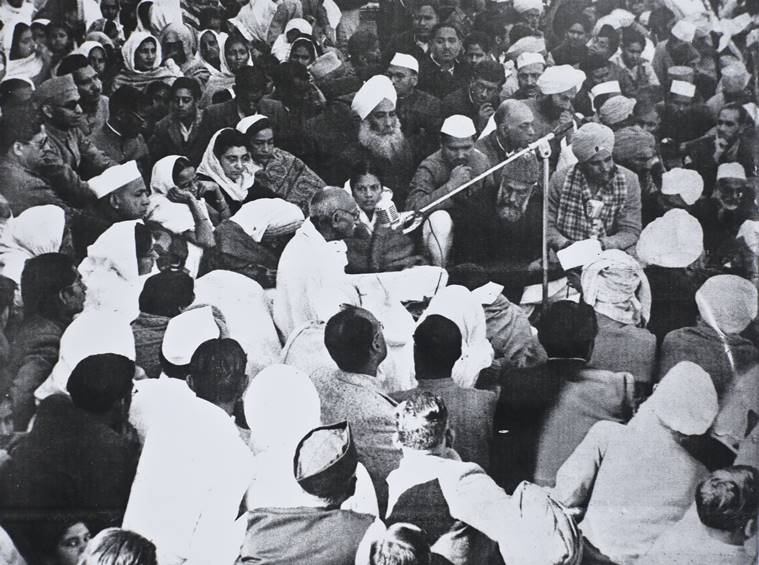 Mahatma Gandhi addressing the crowd at Mehrauli Dargah. (Source: Express Photo)
Mahatma Gandhi addressing the crowd at Mehrauli Dargah. (Source: Express Photo)
In 1920, when he took over the reins of the Congress, one of the first moves by Gandhi was to give it a constitution with which it could enter a decisive phase of the struggle for India’s independence. Now, in what ended up being the last 12 hours of his life, records show, Gandhi was devoted to preparing a new constitution for the Congress for a post-Independence India.
Later in the day, he wore a peasant’s bamboo hat and lay down under the January sun with an abdominal mud pack. One of his aides read out an angry letter asking him to retire to the Himalayas. A similar outburst had come from another refugee the day before. That had shocked him, and this too left its mark, note the records.

Meanwhile, people from all over sought an audience. Two from Punjab spoke about the “Harijans” of their province, visitors from Sindh followed, then a representative from Ceylon (now Sri Lanka), who was accompanied by his daughter, asked Gandhi to give a message for Ceylon’s independence day on February 14. As per the records, the girl asked for his autograph — the last Gandhi was to give.
On Tees January Marg in New Delhi, on the ground floor of Birla House, these details of Gandhi’s last few hours are etched on the walls. He had arrived from Calcutta on the morning of September 9, 1947, and had been persuaded to stay in a small portion of the 12-bedroom house built by the industrialist Ghanshyamdas Birla. He had stayed there several times in the past, but this is where he would spend the last 144 days of his life. And, this is where he would die.
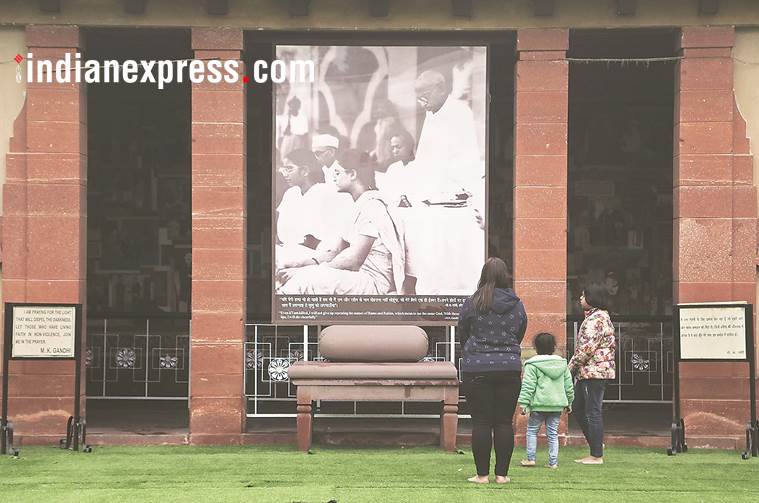 The seat from where he conducted his prayer meetings. (Express Photo by Abhinav Saha)
The seat from where he conducted his prayer meetings. (Express Photo by Abhinav Saha)
In a small enclosure leading into the ‘film room’ at Gandhi Smriti, as it is called to mark the place of his martyrdom, there are pictures of Gandhi’s last meeting with India’s first deputy prime minister, Vallabhbhai Patel, on that fateful Friday. There were reports of a rift between Patel and prime minister Jawaharlal Nehru, which Gandhi was keen to sort out. During this meeting, he would tell his grand-niece Manu, to convey to two leaders from Kathiawad, Gujarat, who had requested an audience: “Tell them that I will (meet), but only after the prayer meeting, and that too if I am still living.”
At 5 pm, another grand-niece, Abha, showed him the watch. He got up, wore his chappals, and stepped through a side door into the twilight. He was late by 10 minutes for the evening prayer —during these prayer meetings, attended by hundreds, he would deal with almost every subject that concerned the nation, big and small. He took a different route that day, not his usual past the leafy pergolas, to the right side of the grounds. Seeking to save time, he cut directly across the lawn to some steps leading to the terrace where the prayers were held, as per museum records.
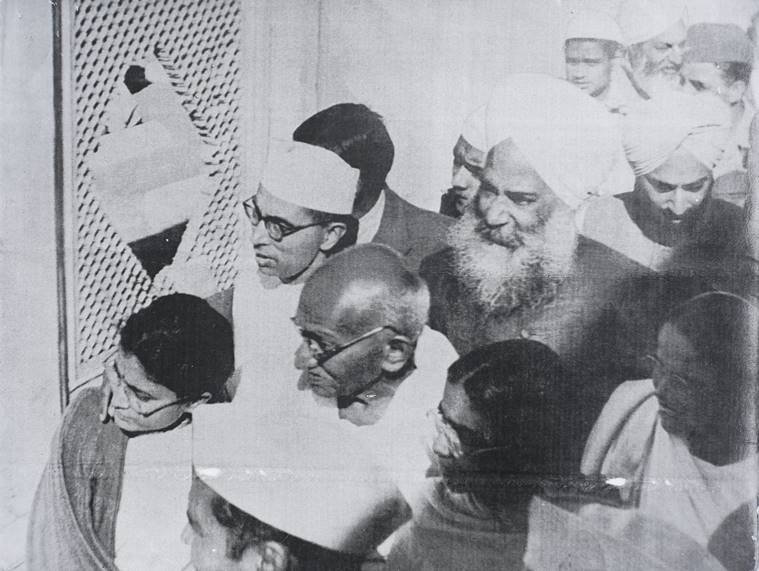 Mahatma Gandhi entering the Mehrauli Dargah. (Source: Express Photo)
Mahatma Gandhi entering the Mehrauli Dargah. (Source: Express Photo)
Black letters on a white, framed background detail what happened next: “His assassin saw Gandhiji coming straight towards him… The Mahatma had taken just few paces from the steps. He elbowed his way through… and approached the Mahatma with his palms joined. The tiny black Beretta pistol was concealed between them. He bowed low and said, ‘Namaste Gandhiji’. Gandhiji joined his palms in acknowledgement. Manu thought the man was going to touch Gandhi’s feet, a practice the Mahatma did not like. She motioned him away….”
Then, “The assassin pushed Manu forcefully aside… the items in her hands fell. When the rosary dropped, she bent down to pick it up… at this precise moment, a burst of deafening blasts ripped apart the peaceful atmosphere as he fired three bullets into Gandhiji’s abdomen and chest.”
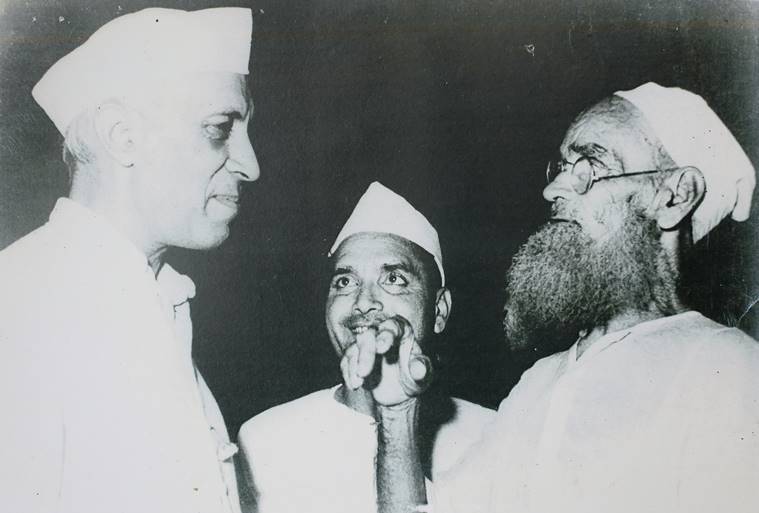 Jawaharlal Nehru at the Mehrauli Dargah. (Source: Express Photo)
Jawaharlal Nehru at the Mehrauli Dargah. (Source: Express Photo)
Saying “Hey Ram, Hey Ram”, Gandhi slumped to the ground, his white shawl turning crimson with blood. Within seconds, he was dead. “I am told I was there, all of three years old, but have no memory of it, which does not matter, as a photograph, taken an hour or so after Gandhi was struck down, is immovably etched in mind’s eye,” says his grandson Gopalkrishna Gandhi, now 73.
Seventy years on, inside Birla House, this moment is animated, projected onto a dull white wall, set to the striking voice of Pandit Kumar Gandharva rendering Ud jayega hans akela. The assassin is unnamed. Outside, English roses — the desi ones don’t hold up well —line both sides of the now enclosed space where he was gunned down.
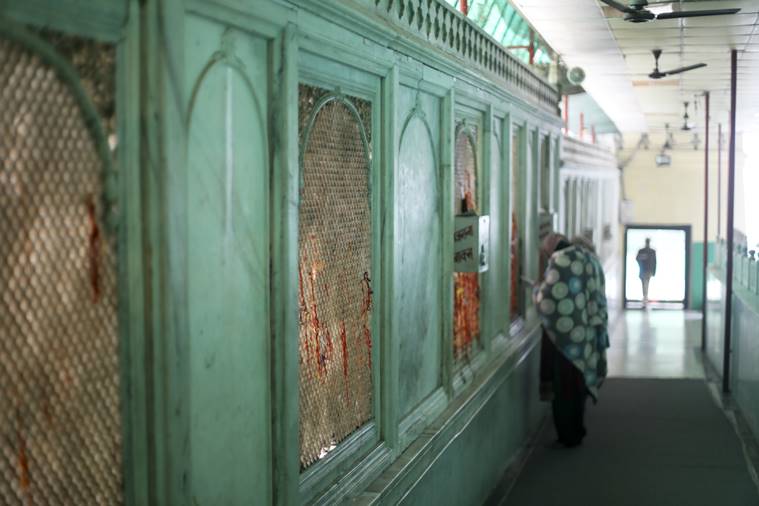 Present day Mehrauli Dargah. (Source: Express Photo)
Present day Mehrauli Dargah. (Source: Express Photo)
The sight, visitors such as Sujan Singh from Darjeeling say, makes them “really scared”.
***
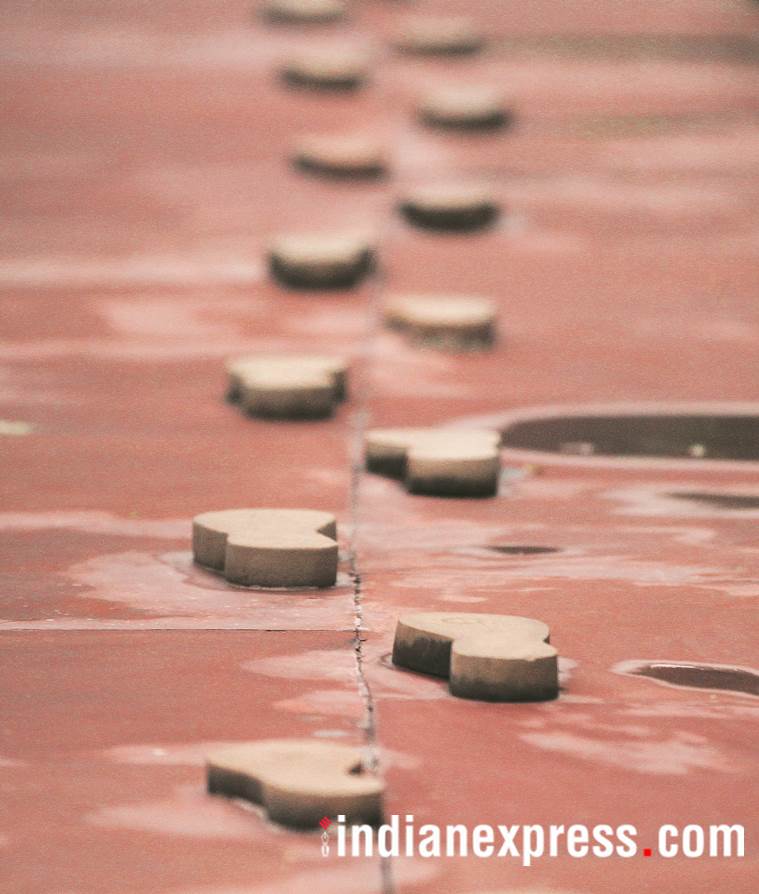 Gandhi Smriti: The footsteps marking the route, not his usual one, that Gandhi took on Jan 30, 1948, from his Birla House room to the prayer meeting, before he was shot. (Express Photo by Abhinav Saha)
Gandhi Smriti: The footsteps marking the route, not his usual one, that Gandhi took on Jan 30, 1948, from his Birla House room to the prayer meeting, before he was shot. (Express Photo by Abhinav Saha)
It was never Gandhi’s intention to stay on in Delhi. “Before coming to Delhi, he was in Calcutta, and from there he wanted to go back to Noakhali,” says Professor and author Apoorvanand, who teaches Hindi at the University of Delhi. “To protect the Hindus and bring sanity to the Muslims,” says Apoorvanand. “It was always believed that Gandhi favoured Muslims, and here was an example which defied that.”
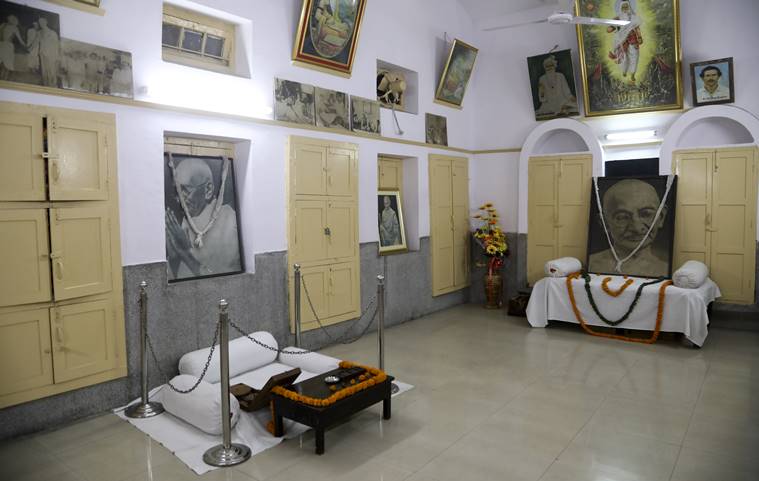 The Valmiki Mandir, within which is a room where Gandhi used to stay, is now run wholly by the Valmiki Samaj Committee, and not by the Ministry of Culture that maintains the museum at Birla House. (Source: Express Photo)
The Valmiki Mandir, within which is a room where Gandhi used to stay, is now run wholly by the Valmiki Samaj Committee, and not by the Ministry of Culture that maintains the museum at Birla House. (Source: Express Photo)
Yet, while the killings in Noakhali were in the hundreds, thousands were getting killed in the Capital of India, few months after lines were drawn to form new nation states.
“In Calcutta, he was getting news of the riots in Punjab. He had an audacious plan, to take with him the Hindus and Sikhs who had been driven out of Punjab, and bring back the Muslims who had fled India for Pakistan,” says Apoorvanand. “Gandhi felt, ‘How can you break up your neighbourhood for such an abstract idea of a nation?’.”
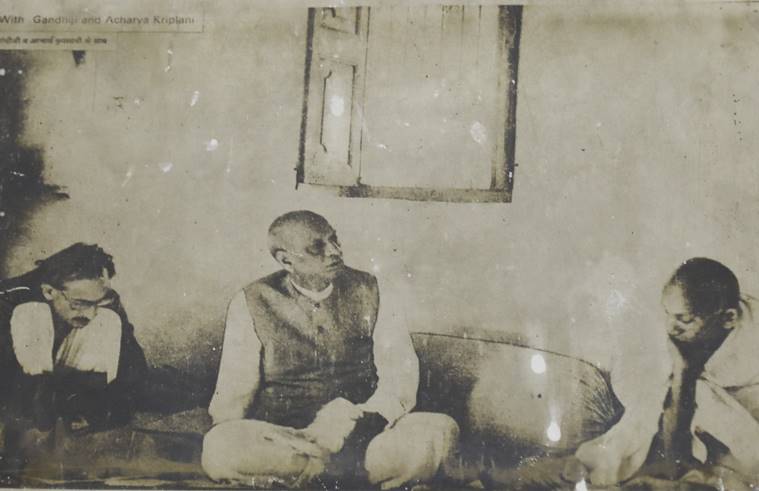 An old photograph of Nehru and Gandhi at the Valmiki Mandir. (Source: Express Photo)
An old photograph of Nehru and Gandhi at the Valmiki Mandir. (Source: Express Photo)
When Gandhi landed in Delhi on September 9, 1947, it was like a graveyard. His earlier ‘home’ in the Capital, the Balmiki Basti, had been turned into a camp for refugees from across the border. In October 2014, coinciding with Gandhi’s birth anniversary, it was from this basti on Delhi’s Mandir Marg that Prime Minister Narendra Modi launched his Swachh Bharat campaign.
The Valmiki Mandir, within which is a room where Gandhi used to stay, is now run wholly by the Valmiki Samaj Committee, and not by the Ministry of Culture that maintains the museum at Birla House. “Guess why that is the case?” says writer, documentary filmmaker and history buff Sohail Hashmi. Gandhi Smriti Darshan Samiti (GSDS) Director Dipankar Shri Gyan adds, “Birla House is a government property and we get funds to maintain it. But that is not the case at Balmiki Basti.”
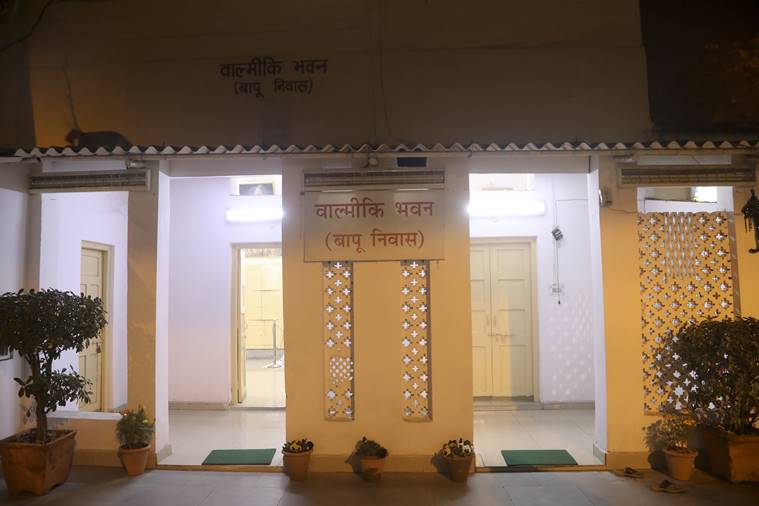 Bapu Nivas at Valmiki Bhavan. (Source: Express Photo)
Bapu Nivas at Valmiki Bhavan. (Source: Express Photo)
Once Gandhi was persuaded to stay at Birla House, the room was carefully selected, with an adjoining bathroom, and the furniture removed to meet the needs of the new occupant.
On a Sunday afternoon on the strikingly quiet premises, now called Gandhi Smriti, Tejawsi Pandey, 1, is learning to walk in squeaky shoes with the help of his mother, past the bed on which Gandhi was placed immediately after he was shot.
An Irish visitor asks his wife, “Are you going to spend all day reading this?” referring to the information at the museum. “Not at all,” his wife replies.
In December 1947, in a letter to a friend, included in the museum records, Gandhi wrote about the decision to stay at Birla House: “Delhi was like a dead city. The riots had just broken out and the Bhangi Colony was full of refugees. Sardar Patel therefore had decided to put me up at Birla House… My main (objective) in staying in Delhi is to give to the Muslims whatever comfort I can. That (objective) was served better by my staying at Birla House. Muslim friends felt safer in coming here than in the poor quarters of Delhi…”
About a month later, on January 11, 1948, a group of Delhi’s Muslims did meet Gandhi here, asking for help in their “passage to England”, Apoorvanand wrote in The Indian Express on January 13, 2018. They had decided not to go to Pakistan, but it was impossible for them to stay in India. Gandhi felt defeated. Apoorvanand wrote: “Gandhi struggled within himself to find a way. As earlier, he turned to his inner voice which had been beckoning for a long time: He had to fast again.”
On the walls of Birla House are quotes from Gandhi’s prayer discourse the next day, on the evening of January 12, 1948: “I yearn for friendship between the Hindus and Sikhs and Musalmans. It subsisted between them only the other day. Today, it is non-existent. It is a state that no Indian patriot worthy of the name can contemplate with equanimity.” The fast, Gandhi said, would begin with the first meal the next day. The period: indefinite. Recalls historian Rajmohan Gandhi, another grandson, “When he saw his grandchildren, he would hug them, pat them or hit them on the back. Even though he was fasting, the hand came down with such energy.”
 Kohale (right) who is here from Maharashtra. (Express Photo by Abhinav Saha)
Kohale (right) who is here from Maharashtra. (Express Photo by Abhinav Saha)
Hashmi details three reasons that drove Gandhi’s decision to fast: India’s hesitation in handing over Rs 55 crore that had to be transferred to Pakistan; the Hindu Mahasabha’s call against Muslims; and to ensure peaceful conditions for holding of the annual Urs of Bakhtiyar Kaki in Mehrauli. “The shrine of Sufi saint Qutbuddin Bakhtiyar Kaki is amongst the oldest in Delhi. He was a venerated patron saint of the city, and in 1947, the shrine came under attack… Few were left of the sizeable Muslim population there,” says Hashmi.
Historian Ramachandra Guha, who is working on a biography of Gandhi, says his visit to the Bakhtiyar Kaki shrine on January 27, 1948, was significant. “In his adult life, he only visited a shrine twice. The first visit was to the Meenakshi Temple in Madurai (in 1934 he went up to the doorway, and in 1946 to mark the temple entry of Dalits), and the next was to this shrine in Mehrauli. It was a sign of support to the custodians of the dargah,” Guha says.
***
At 8 am on a Thursday, there is a chilly draft at the Qutbuddin Bakhtiyar Kaki Dargah in Mehrauli, around 10 km from Birla House. The men lounging on the premises have heard of Gandhi’s visit here three days before he died, but the marble stone inscribed in Urdu to mark the occasion has mysteriously vanished. Fauzan Ahmed Siddiqui, who joined the dargah committee as manager in 2008, says the months following Independence were tumultuous, and that “the effects were seen within the dargah”.
He also explains the general unease among the staff when it comes to talking about the visit now. “Our staff have all joined in the last 10 years. They must think ‘Galti na ho jaye hamse (We may make a mistake)’ while recollecting the event.”
Towards the back, near the dargah’s ‘Langar Khana (community kitchen)’, there is some proof of Gandhi’s visit, in laminated black-and-white images, kept locked by Jamal Ahmed Qutbi. His father, Hilal Qutbi, was present during the visit. “I remember being told that at least 2,000 people came,” says Jamal, showing a photo that has Indira Gandhi sitting to the left of Gandhi. The photos are passed around among the other men present.
An All India Congress Committee Minority Cell letter from 1989, in the dargah’s records, mentions Jamal’s father and his relative, Peerzada Khwaja Syed Rehmat Qutbi. “It is worth noting that three days prior to his martyrdom, Mahatma Gandhi held a prayer meeting in Dargah Qutub Saheb… Gandhiji had requested Pandit Jawaharlal Nehru to get the dargah repaired as it had sustained extensive damage during the riots in 1947. Panditji carried out the wishes of Gandhiji after his martyrdom,” the letter states.
Gandhi asked Nehru to allocate Rs 50,000 for the damages, Hashmi says.
After his visit, Gandhi himself wrote, as per his collected works (Volume 98 p.98-99): “Esteemed as second only to the shrine at Ajmer, it (the Qutbuddin Bakhtiyar Kaki Dargah) is visited every year not only by Muslims but by thousands of non-Muslims too. Last September this shrine was subjected to the wrath of Hindu mobs. The Muslims living in the vicinity… for the last 800 years had to leave… Though Muslims love the shrine, today no Muslim can be found anywhere near it… It is the duty of the Hindus, Sikhs, the officials and the Government to open the shrine again and wash off this stain on us… The time has come when both India and Pakistan must unequivocally declare to the majorities in each country that they will not tolerate desecration of religious places, be they small or big. They should also undertake to repair the places damaged during riots.”
Even today, Jamal says, the shrine, from where Delhi’s famed Phoolwalon Ki Sair sets off, draws more Hindu visitors.
***
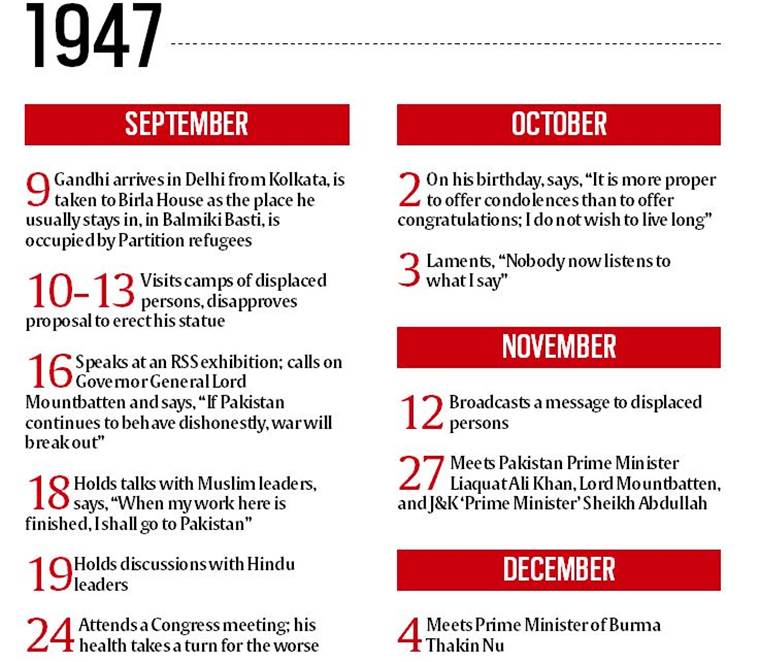
 Tracing the journey of Mahatma in his final years. (Source: Gandhiashramsevagram.org)
Tracing the journey of Mahatma in his final years. (Source: Gandhiashramsevagram.org)
It was at the ‘Satya Ahimsa’ ashram on the first floor of Birla House that Lalita, now 30, was first asked to greet visitors. It was in 2006, a year after then prime minister Manmohan Singh inaugurated the multimedia museum on that floor. “I used to get tongue-tied before visitors. Till then, I was never really given an opportunity to speak freely. Not at home, not in school,” she says. “I was also terrified of the technology.”
It was here that Lalita would also meet her future husband, Samir Banerjee, who now works as a volunteer in Raj Ghat. Before coming to work here, she laughs, she didn’t know there was a place that marked where Gandhi died. In awe, she often told Banerjee “tameez se baat karo (speak properly)”.
There are 36 volunteers in all at the museum. Several come from NGOs or orphanages, says GSDS Director Gyan.
One of them, Shashi Prabha, teaches embroidery at the tailoring unit on the premises, which provides a six-month certificate course to girls and women from underprivileged backgrounds learning to make khadi clothes. The Srijan store on the premises stocks the products; currently a range of colourful frocks for toddlers.
Lalita’s colleague Kalpana too met her husband at the GSDS museum. Telling visitors about the makeshift exhibition that runs parallel to the last steps that Gandhi took before he was assassinated, Kalpana says, “Two kinds of people visit the museum. The ones with a blank mind, ready to allow me to fill it up with information, and the ones who are here to provoke. ‘It was Gandhi who divided up the nation’, the latter often tell me, angrily,” she says. “But I love this job. It is a meeting of minds from all walks of life and from all over the world.”
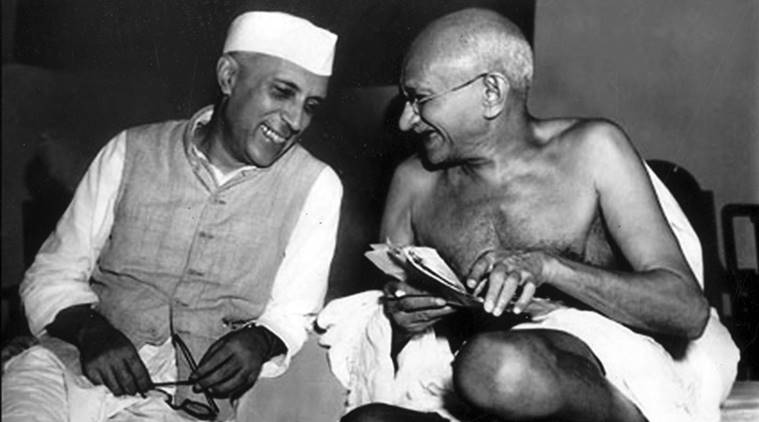 Prime Minister Pt Jawahar Lal Nehru and Mahatma Gandhi. (Express archive photo)
Prime Minister Pt Jawahar Lal Nehru and Mahatma Gandhi. (Express archive photo)
Today Ghansham Pikle and Dilip Kohale of the ‘Akhil Bharatiya Sri Gurudev Sewa Mandal’ are here from Maharashtra. As they click photos on cellphones, Kohale says, “We plan to organise a whole day of chanting and prayers for peace and harmony at Raj Ghat in May, that’s why we are here.” At least 4,000 people are expected to attend, he adds.
Six members of a newly-formed political party, Youth India For Peace, are here from Bengaluru. They carry posters and flags. “We came to register our party, which is an ‘all faiths unite together’ sort of party. See, we have two Christians, two Muslims and three Hindus here,” says one of the founders, G Venugopal, pointing at his colleagues. “It was only apt that we paid Gandhiji a visit.”
The museum gets around 3,000-odd visitors daily, says Gyan. “On Gandhiji’s birthday (October 2) and Martyr’s Day (January 30) we hand out 7,000 invitations, of which 5,000 are with names on them. The remaining 2,000 are left at the gate for any visitors who come. The limit on invitations is for security reasons, since VIPs come on those days.”
The GSDS’s lawns are getting spruced up for this year’s Martyr’s Day; the late-afternoon function on January 30 is to be attended by both Modi and President Ram Nath Kovind. Four men replace tiles, some clean the garden, and the supervisor assures Gyan that a hut damaged by falling dried palm leaves, which also took down a photograph of Gandhi, will be the first thing to be replaced. Everyone is preoccupied with a langur that was brought to ward off the monkeys but has broken its chains and is wandering around the campus.
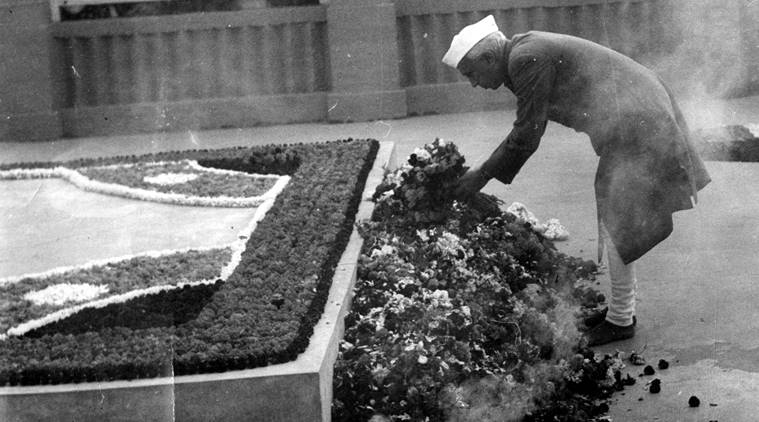 Prime Minister Pandit Jawahar Lal Nehru lying the wreaths at the Samadhi of Mahatma Gandhi. (Express archive photo)
Prime Minister Pandit Jawahar Lal Nehru lying the wreaths at the Samadhi of Mahatma Gandhi. (Express archive photo)
Elsewhere, a couple from Argentina are squinting at the small print inside the museum. Over the course of the day, beginning 9 am, they have visited the Jama Masjid, taken a rickshaw ride around Chandni Chowk, posed for a photograph outside Red Fort, and after this visit to Gandhi Smriti, plan to proceed to Bangla Sahib, India Gate, Rashtrapati Bhavan, and Humayun’s Tomb, before calling it a day at Qutub Minar at 6 pm.
“I usually take my clients only to Raj Ghat and rarely come here,” says their guide Rajendra Sharma. “There are so many monuments in Delhi and we are on a strict time limit. Besides, the client has not come here to research Mahatma Gandhi.”
Apr 18: Latest News
- 01
- 02
- 03
- 04
- 05















